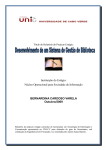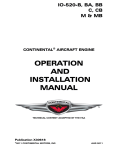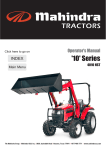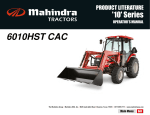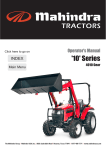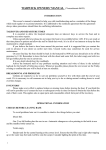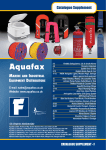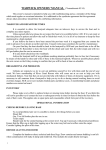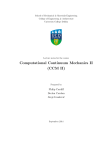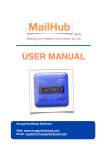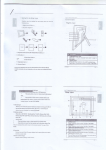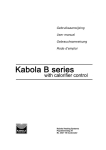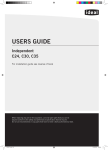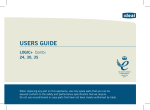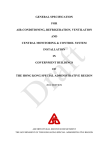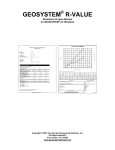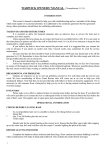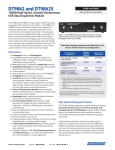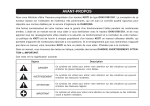Download Engine Models - Canaline Engines
Transcript
Canaline Marine Engines Engine Models Canaline 25 Canaline 30 Canaline 38 Canaline 42 Canaline 52 Canaline 60 Canaline operators handbook Failure to read this or carry out the required service programme may invalidate your warranty Index Introduction 4 Engine Identification 5 Safety precautions 6 Canal Boat Specification 8 Starting / Stopping 9 Fuel and Oil Specifications 12 Maintenance Schedule 15 Installation Information Wiring diagrams Anti Vibration Mounts / Alignment installation Calorfier Connections / Position PRM 80/120 Cable installation 23 29 31 33 Fast Moving Parts list 34 UK Dealer Network 35 RCD Certificate 36 Warranty Terms and conditions 37 Service Record 40 Warranty registration card Loose Introduction This Canaline Marine diesel engine is based on the Kioti diesel engine which is manufactured by the Daedong Industrial Co Ltd. Engines Plus Ltd wishes to thank you for purchasing your new Canaline Marine Diesel engine. Your new engine is the result of many years of research and development and high quality manufacturing, this engine is designed based on strict quality standards established by the unit assuring quality of Kioti genuine components. Its knowledge on the operation of the diesel engine is based on faithful services and reliability for years. This manual makes users familiar with the diesel engine and provides useful information on safety, operation, and maintenance of the diesel engine. To get the fullest use and benefit from your marine engine, it is important that you install, operate and maintain it correctly. This manual, along with gearbox operators’ handbook, is designed to help you do this. Please read this manual carefully and follow its operating maintenance recommendations, along with the installation guidelines. This will ensure many years of trouble-free and economical engine operation. Should you require further advice, technical assistance or an engine service, please contact your nearest marine engine outlet, he knows your engine best and is ready to meet your requirements. On completion of the warranty registration card, you will receive a warranty certificate which forms part of your warranty agreement with Engines Plus Ltd All information, illustrations, and specifications contained in this Manual are based on the latest product information available at the time of publication. Engines Plus Ltd is a mariniser of industrial diesel engines, of which the Canaline product is part of our product portfolio. Engines Plus Ltd produces this manual for use on the Canaline marine engine based on the Kioti Diesel engine. Engines Plus Ltd reserves the right to make changes in this manual at any time without prior notice. The information given is subject to the company’s current conditions of Tender and Sale, is for the assistance of users, and is based upon results obtained from tests carried out at the place of manufacture and in vessels used for development purposes. We do not guarantee the same results will be obtained elsewhere under different conditions. 4 Engine Identification NOTE: In all communications with the Engines Plus Ltd or a local dealer the engine serial number and engine type must be quoted. The engine serial number is on the top of the engine, on a designated number plate. As part of your engine warranty please return your registration card, which is supplied loose, as soon as possible. Engine Information Fill in your engine information below, so you have it to hand when contacting your local dealer. Engine Type: EP Serial No: Gearbox Type: Gearbox Number: Date of Installation: 5 Safety Precautions Keep the engine, gearbox and surrounding area clean, including the area immediately below the engine. Drives – Power Take Off Areas Gearbox Output Flange The purpose of the marine diesel propulsion engine is to provide motive power to propel a vessel. Accordingly the gearbox output shaft rotates at between 133 and 2400rev/min. This flange is designed to be coupled to a propeller shaft by the installer and steps must be taken to ensure adequate guarding. Forward End Drive Engines are supplied with unguarded vee and poly vee belt drives to power the fresh water pump and battery-charging alternator. The installer must ensure that it is not possible for injury to occur by allowing accessibility to this area of the engine. The pulleys run at high speed and can cause injury if personnel or clothing come in contact with the belts or pulleys, when the engine is running. Exhaust Exhaust Outlet Diesel marine propulsion engines emit exhaust gases at very high temperatures – around 400 - 500°C. Engines are supplied with either wet exhaust outlet (water injection bend) or dry outlet (dry exhaust stub) – see engine price list. At the outlet next to the heat exchange header tank, the exhaust outlet can become very hot and if touched, can injure. This must be lagged or avoided by ensuring adequate guarding. It is the responsibility of the installer to lag the exhaust system if a dry system is used. Exhaust gases are harmful if ingested, the installer must therefore ensure that exhaust lines are lead overboard and that leakage in the vessel does not occur. Fuel Fuel Lines Diesel engines are equipped with high pressure fuel injection pumps, if leakage should occur, or if pipes fracture, fuel at high pressure can harm personnel. Skin must be thoroughly cleaned in the event of contact with diesel fuel. Fuel Supply Connections Engines are supplied with 8mm compression fittings. The installer must ensure that when connections are made, they are clean and free of leaks. Oil The Canaline marine propulsion package is supplied with 2 dipsticks, one for the engine and one for the gearbox. Ensure dipsticks are returned and secure after checking, if not oil leaks can cause infection when touched. Do not 6 remove dipsticks whilst engine is running, as this can cause oil to blow out. All oil must be removed from the skin to prevent infection. Scalding An engine running under load will have a closed circuit fresh water temperature of 71° to 85°C. The pressure cap on the top of the header tank must not be removed when the engine is running. It should only be removed when the engine is stopped and has cooled down. Transportation/Lifting Engines are supplied on transportable pallets. Lifting eyes on engines are used for lifting engine and gearbox assembly only, not the pallet and associated kit. GENERAL DECLARATION This machinery is not intended to be put into service until it has been incorporated into or with other machinery. It is the responsibility of the purchaser/installer/owner, to ensure that the machinery is properly guarded and that all necessary health and safety requirements, in accordance with the laws of the relevant country, are met before it is put into service. Note: Recreational Craft Where applicable, the purchaser/installer/owner and operator must be responsible for making sure that the Recreational Craft Directive 94/25/EC is complied with. 7 Canal Boat Engines – Technical Data Model Canaline Canaline Canaline Canaline Canaline Canaline 25 30 38 42 52 60 Cylinders 3 3 4 4 4 4 Bore 75.0 80.0 83.0 83.0 87.0 87.0 Stroke 76.0 92.4 92.4 92.4 92.4 102.4 CC 1000 1390 1999 1999 2179 2430 Combustion Indirect Injection Cooling Keel Cooled BHP 22 28 38 42 52 60 Max r/min 3000 3000 2600 3000 3000 3000 Oil Capacity 3.8 5.8 8.0 8.0 8.0 9.7 Weight 130 205 235 237 248 256 Alternator 50 & 90 50 & 100 50 & 100 50 & 175 50 & 175 50 & 175 Gearbox PRM 80 PRM 80 PRM 120 PRM 150 PRM 150 PRM 150 Note: The specification details above are our standard configurations. 8 Starting and Stopping Important checks prior to use Your engine has been filled with new oil for both engine and gearbox when it leaves the factory. However, please check, see section on engine maintenance. Ensure the engine is free to turn without obstructions, and daily checks have been carried out. Ensure battery is fully charged and connected (the isolator is in the ‘ON’ position). Ensure Morse speed and gearbox cables are fitted correctly and that cable travel lengths are correct. Ensure engine is out of gear with 1/3 throttle – see single lever control instruction manual Ensure fuel taps from fuel tank have been turned on CAUTION: for safety’s sake conduct inspection before start up with engine stopped. Engine starting On turning the key to position “1” on your panel, the panel will go through a procedure, to ensure all lights and the buzzer are working, once this has been completed you can then start the engine. First Start of the day, from cold or initial installation Turn the Key to the “1” position. Turn the Key to the Pre-Heat position and hold until the yellow light goes out Turn the Key to the Start/Crank position and release when the engine fires. Starting an engine already at running temperature. Turn the Key to Pre-Heat and hold until the yellow light goes out. Turn the Key to the Start/Crank position and release when the engine fires. Ensure alarm buzzer is not sounding and red warning lights are off. Note: If the alternator warning light is still on then increase the engine speed to excite the alternator, then return to idle. The light should then go out. 9 Continuous engagement of the starter to the flywheel ring gear without giving them a break will result in the damaged starter pinion gear and flywheel ring gear. Crank for no longer than 20 seconds, with a 20 second break between attempts. The oil pressure gauge on the deluxe engine control panel will read high on start up and whilst the engine is cold. This is normal it will then decrease. STOPPING Every propulsion engine is fitted with a stop solenoid. To stop engine simply turn the key to the “0” position and the engine will stop. When leaving the boat for an extended period, turn off battery isolator Canaline Engine Control Panels Canaline Engine control panels feature LED Module to indicate as listed below. An Intermediate Panel is shown for illustration only. 1 4 2 5 3 6 1. Yellow ~ Timed PreHeat LED 2. Red & Buzzer ~ Engine Coolant Temperature 3. Red & Buzzer ~ Starter Alternator 4. Green ~ Panel Power 5. Red & Buzzer ~ Engine Oil Pressure 6. Red & Buzzer ~ Auxiliary / Domestic Alternator Illuminates when Key is switched to Preheat position to indicate Preheat time. LED Illuminates and Buzzer sounds if Engine Temperature is too high. LED Illuminates and Buzzer sounds if no charge from Alternator or Belt breaks. LED illuminates when Key is switched on. LED Illuminates and Buzzer sounds if Oil Pressure is too low. LED Illuminates and Buzzer sounds if no charge from Alternator or Belt breaks. 10 Checks during operation While operating the engine, keep checking whether all parts of the engine are operating smoothly and properly. COOLING SYSTEM If steam or coolant is escaping from the overflow tube; stop the engine, allow it to cool, and check the following and correct as needed. 1. 2. 3. 4. of 5. Check for cooling system leaks. Check for obstructions that block cooling air. Check and adjust the fan belt tension. Ensure that the system is filled to the correct coolant level with the proper mix anti-freeze and water. Check the radiator cap for proper type and condition. IMPORTANT To avoid personal injury : DO NOT remove the manicooler cap while the engine is hot. Pressurized steam or coolant will escape and cause serious injury to you and any bystanders. Open the cap at least 10 minutes after the engine is stopped. OIL PRESSURE LED The oil pressure LED comes on when the oil pressure drops below a safe level. If the lamp comes on while the engine is operated at or above 850 rpm, immediately stop the engine and check the engine oil level. FUEL The fuel tank should never be allowed to become completely empty. An empty tank will allow air into the fuel system; and the engine will not operate without bleeding the fuel system. EXHAUST SMOKE The engine exhaust should be colorless during normal operation within the rated output of the engine. Continuous dark emissions or smoke may indicate improper usage or an engine malfunction. STOP THE ENGINE IMMEDIATELY: 1. If the engine speed suddenly changes. 2. If there is an unusual noise. 3. If the engine exhausts suddenly darkens. 4. If the oil pressure, temperature light or alternator comes on. 11 Fuel and Oil Specifications Fuel Important • It as advisable to fit a fuel/water separator in the fuel supply system. Water in the fuel can damage the injection system. However if the engine is being fitted into an existing boat (re-installation), it is compulsory to fit a fuel/water separator • If a fuel supply shutoff valve is fitted do not use taper tap, only use a ball valve tap. The valve type are more reliable and less likely to let air into the fuel system. • Do not use kerosene, which is very low in cetane rating, and adversely affects the engine. • Be careful not to let the fuel tank become empty, or air can enter the fuel system, necessitating bleeding before next engine start. Fuel selection The following criteria is required for the diesel fuel 1. Must be free from minute dust particles 2. Must have adequate viscosity 3. Must have high cetane value 4. Must have high fluidity at low temperature 5. Must have low sulphur content 6. Must have little residual carbon Diesel fuels Applicable standard JIS (Japanese Industrial Standard) DIN (Deutsche Industrie Normen) SAE (Society of Automotive Engineers) Based on SAE-J-313C BS (British Standard) Based on BS/2869-1970 Recommendation NO. 2 DIN 51601 NO.2-D Class A-1 If fuel other than the specified one is used, engine function will be lowered. Fuel Requirements NOTICE: The fuel injection pump, injector or other parts of the fuel system and engine can be damaged if you use any fuel or fuel additive other than those specifically recommended by Canaline / Kioti. Such damage is not Canaline / Kioti’s responsibility and is not covered by the warranty. To help avoid fuel system or engine damage, please read the following: • Some service stations mix used engine oil with diesel fuel. Some manufacturers of large diesel engines allow this; however for your diesel engine, do not use diesel fuel, which has been contaminated with engine oil. 12 • Do not use any fuel additive (other than as recommended under “Biocide” in this section). At the time this manual was printed, no other fuel additive was recommended. (See your authorisation dealer to find out if this has changed). Fuel system air bleeding The entry of air into the fuel system will cause difficult engine starting or engine malfunction. When servicing such as emptying the fuel tank, draining the water sedimentor, and the fuel filter element change is done, be sure to bleed air. Air Bleeding Procedure: 1. Please use the fuel primer located on top of the fuel filter to prime the engine through with fuel. 2. Start the engine and check the fuel system for fuel leaks. CAUTION: the water/diesel fuel mixture is flammable and could be hot. To help avoid personal injury and/pr property damage to not touch the fuel coming from the drain valve and do not expose the fuel to open flames or sparks. Be sure you do not overfill the container. Heat (such as from the engine) can cause the fuel to expand. If the container is too full, fuel could be forced out of the container. This could lead to a fire and the risk of personal injury and/or vehicle or equipment damage. Biocides In warm or humid weather, fungus and/or bacteria may form in diesel fuel if there is water in the fuel. NOTICE: fungus or bacteria can cause fuel systems damage by plugging the fuel lines, fuel filters or injector. They can also cause fuel system corrosion. If fungus or bacteria has caused problems, you should have your authorised dealer correct these problems. Then, use a diesel fuel biocide to sterilise the fuel system (follow the biocide manufacturers instructions). Biocides are available from your dealer, service stations, parts stores and other automotive places. See your authorised dealer for advice on using biocides in your area and for recommendations on which biocides you should use. Smoke suppressants Because of extensive testing of treated fuel versus untreated fuel, the use of a smoke suppressant additive is not recommended because of the greater possibility of stuck rings and valve failure, resulting from extensive ash deposits. Lubricant The quality of engine oil may largely affect engine performance, startibility and engine life. Use of unsuitable oil may result in piston ring stick, piston and cylinder seizure and accelerate the sliding surface wear causing increased oil consumption, lowered output and finally engine failure. To avoid this, use the specified engine oil. 13 Engine Oil Selection Engines Plus recommend that an API CC grade oil is used in all of its marine engines. Alternatively an API CD grade can be used if an API CC grade is unavailable. The correct grade oil is available from your local marine dealer. • • 14 5 litres API CC 15W/40 – EP part no - EP710008 25 litres API CC 15W/40 – EP part no - EP710009 Maintenance Schedule Daily or every 8 hours running • Check engine oil level • Check gearbox oil level, see gearbox manual • Check coolant level • Check drive belt tension, adjust if necessary • Check colour of exhaust fumes and unusual engine noise on start up • Check stern gland lubrication After first 50 hours • Change gearbox lubricant (see separate gearbox manual) • Change engine lubricating oil • Change oil filter • Change fuel filter • Check fuel contamination and drain off water trap/agglomerator if fitted • Check all water pipes are not chaffing and for any leaks, and adjust if necessary • Check all fuel pipes are not chaffing and for any leaks, and adjust if necessary • Check exhaust system for any leaks, etc, and adjust if necessary • Check wiring looms and cables are not chaffing, and adjust if necessary • Check coupling alignment and ensure all bolts are tight • Check bolts/nuts on the anti vibration mounts are tight and secure • Check control cables installation to ensure gearbox is correctly being engaged, and adjust if necessary Every 200 hours or every year • As 50 hours and the following • Check air cleaner element and replace if necessary • Change oil and oil filter Every 400 hours • As 50 & 200 hours and the following • Change air cleaner element • Change fuel filter • Change anti-freeze • Check electrical equipment, condition of hoses and belts, replace as necessary 15 Checking engine oil level For quantities of oil please refer to page 7. When checking the engine oil level, do so before starting or more than five minutes after stopping. 1. To check the oil level, draw out the dipstick, wipe clean, re-insert it and draw it out again. Check to see that the oil level lies between the two major marks on the dipstick. (please ignore the middle smaller mark) 2. If the level is too low add new oil via the oil filler port, to the specified level – do not overfill. Engine Dipstick Engine Oil goes in here Important When using oil of different make or viscosity from the previous one, drain old oil. Never mix two different types of oil. Engine oil and filter should be changed after the first 50 hours running time and then every 200 hours or every year. Oil filter is a cartridge type mounted on the side of the engine. 16 Changing Engine Oil 1. 2. 3. Run the engine for 10 minutes to warm up the oil. Your engine is provided with a sump drain pump. Turn the tap to “on”. Use the hand pump as shown to pump out the oil into a bucket. Turn the tap to off position and replace end cap. Unscrew the oil filter and replace with a new one. See diagram below Sump drain Pump Oil Filter Sump drain Pump - tap Note: it is best to have a plastic bag wrapped around the filter to catch any oil left in the system. (Always keep your bilges clean!) Before screwing in the new filter spread a thin film of oil round the rubber gasket to ensure a good seal and screw in – hand tight. 4. Fill the engine with new oil, refer to page 13 for specification, as described above. Note: once you have re-filled the engine will oil, run the engine for about 5 minutes, so the oil can be pumped around the engine and into the new filter. Stop the engine, and let it settle for about 10 minutes, and re-check the oil level, fill if required. 17 Changing the fuel filter 1. The fuel filter is a spin type. Remove by turning anti-clockwise when viewed from below, see picture Replace the fuel filter cartridge every 400 hours. Remove metal bung from old fuel filter and fit to new fuel filter (see below) Apply fuel oil thinly over the gasket and tighten into position – hand tight Prime fuel system as indicated on page 13 Check for leaks 2. 3. 4. 5. 6. Note: Do not get fuel on the flexible mounts. Fuel Filter Electric Fuel Lift pump Only on CL42/52/60 Metal bung in Fuel filter, must be transferred to new fuel filter Checking Gearbox Oil Level – please refer to gearbox manual, but on the PRM 80 and 120 gearbox, please ensure the following Ensure the oil mark is below the marker on the dipstick (shaded). Ensure thread (shaded) is fully screwed down into case with its relevant bonded seal when measuring the oil level. Never exceed the maximum oil level on the dipstick! Always use ATF Dextron II or III for your gearbox 18 Freshwater system New engines are supplied with the freshwater drained off. instructions must be followed to fill the system. The following (a) (b) (c) Mix up in a clean bucket the correct strength of anti-freeze solution. Check that the drain tap or plug is turned off. Fill engine with freshwater/anti freeze solution through the top of the header tank with the filler cap removed. (d) Fill the header tank to the top of the filler neck and replace cap. Press down firmly on filler cap and hand tighten in a clockwise direction. Note: for keeled cooled engines a much larger quantity of freshwater/anti freeze solution is required depending on the size of the keel cooling tank – refer to the builder. (e) run the engine for 5 minutes on no load (out of gear) and check coolant level. Top up if necessary. (f) Check systems for leaks, including calorifier circuit if fitted. Note: for keel cooled engines it is very important to bleed all the air out of the system before the engine is run on load (check with builders instructions). (g) (h) If a calorifier is fitted care must be taken to see that this is also full of coolant and all the air is expelled. (see calorifier fitting notes under installation section) Run the engine on one third speed for 15 minutes, preferably with the boat tied up. As the system warms up coolant may be expelled from the overflow pipe into the bilge. Stop the engine and allow the engine to cool down before removing the pressure cap and top up the coolant to 25mm below the filler neck. 19 Important Removal of the pressure cap when the engine is hot can cause severe injury from scalding hot water under pressure. Always allow the engine to cool and then use a large cloth when turning the cap anti-clockwise to the stop. This allows the pressure to be released. Press firmly down on the cap and continue to turn anticlockwise to release the cap. (i) Repeat (h) if coolant level is more than 25mm below the base of the filler neck when the engine has cooled down. Run engine on 2/3 speed for 20 minutes, check for leaks and repeat (i) Anti-freeze solutions should be drained off every 500 hours or 2 years which ever is sooner, and replaced with a new solution. (j) (k) Engine water filler cap, integrated into the header tank. 20 Changing the Air filter The Air filter should be changed every 400 hours, once per year or sooner if necessary, the air cleaner fitted to the Canaline marine engines, has a replaceable element, part no EP110529. 1. Remove Air cleaner lid, by unscrewing anti-clockwise 2. Remove and replace element 3. Re-fit lid, accordingly Air cleaner Element 21 Alternator Drive Belts It is important to check both alternator drive belts to ensure both engine performance and to ensure your batteries are charged The 50 Amp alternator drive belt also drives the water pump. 50 Amp Alternator Nut A Nut B Auxiliary Alternator To tighten both belts, please follow these instructions 1. 2. 3. 4. Loosen nuts A Use bolt B to tighten belt Adjust accordingly Retighten nut A after finish Note: Low belt tension can result in engine overheating and in sufficient battery charging. A belt that is too tight may cause bearing failure and belt life may be shortened Note: 50 Amp Alternator fitted to the Canaline 25/30/38 engines are not fitted with bolt style tensioner link. 22 Engine Wiring Diagram Index Engine Type Drawing Number Canaline 25 Engine Wiring Loom Basic Engine Control Panel Intermediate Engine Control Panel Deluxe Engine Control Panel WD910005.2 WD910002.3 WD910003.3 WD910004.3 Canaline 30 / 38 / 42 / 52 / 60 Engine Wiring Loom Basic Engine Control Panel Intermediate Engine Control Panel Deluxe Engine Control Panel WD910001.6 WD910002.3 WD910003.3 WD910004.3 23 Marine Engine Installation Information Anti vibration Mount Installation These mounts are supplied for use where accurate alignment is required, e.g. between the gearbox output shaft and propeller shaft on marine installations. They also provide isolation of the power unit, to minimise the transmission of vibration into the hull. Assembly and adjustment is as below: T opN utʻC ʼ X =7m m N yloc Nut ʻAʼ L ock Nutʻ Bʼ Set the gap ‘X’ between the lower face of the Nyloc Nut ‘A’ and the upper face of Locknut ‘B’ to 7mm. T opN utʻC ʼ X =7m m N yloc Nut ʻAʼ L ock Nutʻ Bʼ 1. Attach each mount to the engine bearers and secure by tightening Top Nut ‘C’ 2. Lower the propulsion unit, complete with mounts onto the beds or support structure, ensuring that the base of each mounts is fully seated. If any clearance between the underside of the mounts and beds is found, proceed as below: 3. (i) the If the gap is less than 2mm, re-adjust Nyloc Nut ‘A’, until the base of mount contacts the bed face. (ii) If the gap exceeds 2mm, a separate packing piece / shim should be fitted. 4. Fit and tighten the bolts fixing the mounts to the bed. Tighten Top Nut ‘C’. Alignment between the Gearbox and Propeller Shaft Flanges should now be checked., preferably using a dial indicator for concentricity and feeler gauges for angular misalignment (see sketch). Adjust alignment by raising or lowering the Nyloc Nut ‘A’, to achieve alignment within the limits of the Gearbox to Propeller Shaft Coupling, as specified by the manufacturer. If a rigid coupling is used, then it is suggested that eccentricity should not exceed 0.25mm (0.010”) total indicator reading and, angular misalignment should be within 0.025mm (0.001”) per 25mm of flange diameter. 29 Coupling alignment procedures should be re-checked after 10/15 hours of operation, during which time any “settling” of the system should have taken place. If this is not possible, the power unit should be raised approximately 1mm on each mount after completing the alignment procedure. 5. If the distance between the underside of Nyloc Nut ‘A’ and the top of Locknut ‘B’ exceeds 15mm, then a 5mm Packing Piece should be inserted between the base of the mount and top face of the beds. Nyloc Nut ‘A’ should then be adjusted to compensate. 6. Following any height adjustment on the mountings, alignment of the Coupling Flanges should be re-checked after tightening the Top Nut ‘C’ and Mount to Bed Bolts securely. NOTE……Locknut ‘B’ should NOT be loosened or adjusted at any time. Calorifier Connection Points – CL30/38/42/52/60 Calorifier connection points are as shown below. Connection stubs are provided and are suitable to accept 15mm (5/8”) dia bore flexible hose. The hose must be secured with suitable hose clips to give a watertight connection capable of withstanding a water pressure of 15 psi. Hoses are not supplied by Engines Plus. HOT WATER OUTLET To Calorifier WATER RETURN From Calorifier If no calorifier is fitted, the connections must be blanked off, They MUST NOT BE CONNECTED DIRECTLY TOGETHER, Blanking plugs are available on request. 31 Calorifier Position The Canaline Marine range has been developed to operate with approximately 3m of piping between the engine and Calorifier, with a minimum number of bends and restrictions in this pipework. We recommend the Calorifier Inlet and Outlet connections be no more than 300 to 450mm either above the top of the engine or below the bottom of the engine sump. Provided these criteria are applied and the system is fully bled of air, then satisfactory performance should result. Both Feed and Return connections are situated on the engine side of the Thermostat and water is therefore allowed to circulate around the Calorifier Circuit at all times. It should be noted that during long periods of engine operation, when no hot water is drawn from the Calorifier, that the hot water temperature within could approach 80 deg C. Under these circumstances, extreme care should be taken when using the hot water circuit. Engine Idle Speed The Canaline Marine engines idle speed should be set between 850 – 900 r/min, however this can be adjusted by the installer if the engine idle speed is incorrect without effecting the engines warranty. To change idle speed, please adjust accordingly Nut A Bolt B Loosen nut A, and adjust idle speed with bolt B, then re-tighten nut A to lock the idle speed, please ensure the cable is then re-adjusted accordingly 32 PRM 80 and 120 Morse control cable installation It is highly important the morse control cable and lever installation is performed correctly, otherwise this may lead to early failure of your gearbox, which would not be covered by warranty. Ensure the cable that operates the selector lever allows the lever to travel fully up to the stops in the forward and reverse positions at all times, we would recommend that you use the inside hole on the lever to ensure the lever fully engages and firmly keep the gearbox in gear. The lever has a section of over throw that the lever should sit in when the gear is selected. The adjustment should be regularly checked as cables can stretch. 33 Parts Bulletin for Canal Boat Marine Engines Engine Type : Kioti Engine designation Oil Filter Element Canaline 25 Canaline 30 Canaline 38 Canaline 42 Canaline 52 Canaline 60 3C100LWS 3A139LWS 4A200LWS 4A200LWS 4A220LWS 4B243LWS E520532091 E6201-32443 Fuel Filter Element E4682-43172 Air Filter Element Thermostat Fan Belt - A section Starter Motor 50 Amp Alternator EP110529 E550073012 Z section EP811120 E576063011 E621364012 90 Amp Alternator 100 Amp Alternator Glow plugs E5500-63016 E7230-64012 N/A N/A EP910655 N/A X EP910586 N/A EP910346 E576065511 E6301-65512 Oil Pressure switch E5500-39013 Oil Pressure Switch / Sender EP910039 Engine Temperature switch EP910512 Engine Temperature Sender EP910041 Top hose EP410048 Aux Alt Drive belt (80 / 100 A) - A Sec 50A Altr EP811030 Aux Alt Drive belt (110/175 Amp) EP410511 EP810975 N/A N/A EP811065 Engine Oil - 5 Litre EP710008 Engine Oil - 25 Litre EP710009 34 E580072531 E6300-72532 EP910590 110 Amp Auxiliary alternator 175 Amp Auxiliary alternator E5800-73011 E564072531 E653063012 Engines Parts – Availability All engines parts are available through your local dealer. Our latest dealer network is available on our website, or listed below is our main parts centres Uxbridge Boat Centre Ltd, Uxbridge Wharf, Waterloo Road, Uxbridge, Middx, UB8 2QX, Tel: 01895 252019 Kings Lock Chandlery Booth Lane, Middlewich, Cheshire. CW10 OJJ. Tel: 01606 737564 Wharf House Narrowboats Braunston Boat Haven, Bottom Lock, Little Braunston, Northants. NN11 7HL Tel: 01788 899041 35 Recreational Craft Directive – Certificate 36 Warranty Terms and Conditions INTRODUCTION Your new Canaline Marine Engine is covered by the Engines Plus Ltd warranty according to the conditions and instructions contained within this document. This warranty only covers the engine. The gearbox is covered by the gearbox manufacturers warranty. OWNER’S OBLIGATIONS The operation, maintenance and care of your Canaline Marine engine, in accordance with the instructions and requirements listed in your Operators Manual, is your responsibility. Records should be kept of all maintenance services performed, including engine oil and filter changes. This record of correct maintenance is required for the purpose of determining warranty coverage on repairs and should be transferred to each subsequent owner. It is also your responsibility to ensure that the warranty registration is filled in by yourself (self certification) and returned to Engines Plus Ltd, as this information forms part of the validation of your engine warranty. The warranty registration must be returned completed to ensure the warranty on your engine is valid, this is the responsibility of the owner. REPORT OF A DEFECT It is the responsibility of the owner of any Canaline product referred to herein to report any defect to Engines Plus Ltd, Distributor, Dealer, Workshop or Boat builder. Such a report must be made as soon as possible and no later than fourteen (14) days from the date when the user first observed the defect. WARRANTY TERMS AND CONDITIONS 1.0 In the event that Goods supplied are defective in that they have a defect that existed at the time of delivery, Engines Plus Ltd shall (at its option) meet the cost of replacing or repairing such defective Goods or part thereof subject to the following:1.1 1.2 1.3 Labour costs will be paid in accordance with Engines Plus Ltd’s standard repair times and standard rates, which are agreed upon before work is carried out. Engines Plus Ltd has the sole discretion to determine whether the Goods shall be returned to Engines Plus Ltd’s premises or repaired at any other location, which Engines Plus Ltd may nominate. Engines Plus Ltd will pay for lubricating oil, coolant concentrate, filter elements, belts, hoses, gaskets and other maintenance items that are not reusable due to such defect. (at its discretion) 37 1.4 1.5 Only distributors, dealers or workshops authorized by Engines Plus Ltd may carry out warranty repairs. No incidental, consequential or related costs such as costs for travelling, transport, extra costs due to the installation in making the products accessible, docking or cranes, loss of use, loss of income, loss of time, loss of profits or damages of any other parts or goods shall be payable under this condition 1.0 by Engines Plus Ltd. 2.0 The warranty in condition 1.0 above does not cover Goods which in Engines Plus Ltd’s opinion have been damaged during transportation, installation or repair or through abnormal use, overload, carelessness, insufficient lubrication, normal wear, use of spare parts other than genuine parts approved by Engines Plus Ltd or through any type of incorrect installation, abuse, misuse, accident or through neglect or failure to follow instructions in the applicable owners manual, maintenance instructions or installation instructions. 3.0 The warranty in condition 1.0 above will be void if You or your representative, employees or contractors have taken abnormal risks or if modifications have been performed, which in the judgement of Engines Plus Ltd have caused or enhanced the damage, or if the security seals have been broken, or settings altered, or if the Goods or any part thereof have been used in violation of the law, or for an unintended purpose. 4.0 The warranty does not cover expendable parts, such as all kinds of filters, belts, gaskets, rubber hoses, fuses, brushes, etc and lubricants. 5.0 The operation, maintenance and care of the Goods in accordance with the instructions and requirements listed in the owners manual and the warranty and service booklet provided by Engines Plus Ltd is your responsibility. Records must be kept of all maintenance services performed, including engine oil and filter changes. This record of proper maintenance is required for the purpose of determining warranty coverage on repairs and should be transferred to each subsequent owner of the Goods. 6.0 All warranty claims must be advised to Engines Plus Ltd prior to work being carried out, and an authorisation number being allocated, to the distributors, dealer or authorized by Engines Plus Ltd workshop. No claims for warranty will be accepted unless previously authorised by Engines Plus Ltd. 38 7.0 The period of cover relating to the warranty in condition 1.0 above is as follows:. MULTIUSER or HIRE USE Pleasure boats Pleasure boats Electrical equipment and turbocharger Work boat engines and associated products Gearbox The earlier of either PRIVATE USE The earlier of either 18 months from the date of despatch from Engines Plus Ltd’s factory or 12 months or 2,000 hours from engine installation 42 months from the date of despatch from Engines Plus Ltd’s factory or 36 months or 1,500 hours from engine installation As above 12 months or 1,500 hours The earlier of either 18 months from the date of despatch from Engines Plus Ltd’s factory or 12 months or 2,000 hours This is covered by the gearbox manufacturer, please consult the gearbox operators handook The earlier of either 18 months from the date of despatch from Engines Plus Ltd’s factory or 12 months or 2,000 hours 8.0 Save where the Goods are sold to a person dealing as a consumer (within the meaning of the Unfair Contract Terms Act 1977) all warranties conditions or other terms implied by law or custom are excluded to the fullest extent permitted by law. 9.0 Engines Plus Ltd shall under no circumstances be liable for any indirect or consequential loss, loss of profits, loss of savings, loss of business or loss of contract. Engines Plus Ltd’s liability whether in contract, tort (including negligence), breach of statutory duty or otherwise shall not exceed the price of the Goods in respect of which any claim arises PROVIDED THAT nothing in these Conditions shall restrict or exclude Engines Plus Ltd’s liability for death or personal injury caused by its negligence. 39 Service Record Proof of Service – 50 Hour Date: Proof of Service – 250 Hour Date: Proof of Service – 450 Hour Date: Proof of Service – 650 Hour Date: Proof of Service – 850 Hour Date: Dealer: Actual Engine Hours: Dealer: Actual Engine Hours: Dealer: Actual Engine Hours: Dealer: Actual Engine Hours: Dealer: Proof of Service – 1050 Hour Actual Engine Hours: Proof of Service – 1250 Hour Actual Engine Hours: Date: Date: 40 Actual Engine Hours: Dealer: Dealer: Notes ENGINES PLUS LTD Unit 11 Taits Hill Industrial Estate Dursley Gloucestershire GL11 6BL Tel: 01453 547273 E-mail – [email protected] www.canaline-engines.co.uk EP910541.4












































